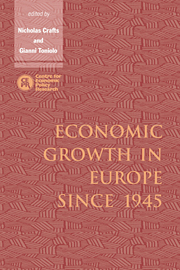Book contents
- Frontmatter
- Contents
- List of figures
- List of tables
- Preface
- List of contributors
- 1 Postwar growth: an overview
- 2 Institutions and economic growth: Europe after World War II
- 3 The varieties of Eurosclerosis: the rise and decline of nations since 1982
- 4 Why the 1950s and not the 1920s? Olsonian and non-Olsonian interpretations of two decades of German economic history
- 5 Convergence, competitiveness and the exchange rate
- 6 British economic growth since 1945: relative economic decline … and renaissance?
- 7 Economic growth in postwar Belgium
- 8 France, 1945–92
- 9 Economic growth and the Swedish model
- 10 Characteristics of economic growth in the Netherlands during the postwar period
- 11 Portuguese postwar growth: a global approach
- 12 Growth and macroeconomic performance in Spain, 1939–93
- 13 Irish economic growth, 1945–88
- 14 Italy
- 15 West German growth and institutions, 1945–90
- 16 An exercise in futility: East German economic growth and decline, 1945–89
- 17 Postwar growth of the Danish economy
- 18 Reflections on the country studies
- Index
13 - Irish economic growth, 1945–88
Published online by Cambridge University Press: 04 August 2010
- Frontmatter
- Contents
- List of figures
- List of tables
- Preface
- List of contributors
- 1 Postwar growth: an overview
- 2 Institutions and economic growth: Europe after World War II
- 3 The varieties of Eurosclerosis: the rise and decline of nations since 1982
- 4 Why the 1950s and not the 1920s? Olsonian and non-Olsonian interpretations of two decades of German economic history
- 5 Convergence, competitiveness and the exchange rate
- 6 British economic growth since 1945: relative economic decline … and renaissance?
- 7 Economic growth in postwar Belgium
- 8 France, 1945–92
- 9 Economic growth and the Swedish model
- 10 Characteristics of economic growth in the Netherlands during the postwar period
- 11 Portuguese postwar growth: a global approach
- 12 Growth and macroeconomic performance in Spain, 1939–93
- 13 Irish economic growth, 1945–88
- 14 Italy
- 15 West German growth and institutions, 1945–90
- 16 An exercise in futility: East German economic growth and decline, 1945–89
- 17 Postwar growth of the Danish economy
- 18 Reflections on the country studies
- Index
Summary
Introduction
Economic growth has made a welcome return to the headlines in the economics profession. Technical advances have made it possible to model the growth process rigorously in the presence of externalities and increasing returns, and this has spawned a vast literature formalizing many of the intuitions about growth previously held by applied economists and economic historians. Whether or not there are diminishing returns to capital, it seems clear that there are diminishing returns to theory, in this field at least. Theory urgently needs to be supplemented with empirical work, be it multicountry regressions or case studies, if the field is to retain its present vigour.
We believe that Irish economic history offers many potential lessons for students of economic growth. While Dowrick and Nguyen (1989), Mankiw et al. (1992) and Freeman (1989) incorporate Ireland1 in their work, Ireland is excluded from consideration in well-known studies such as those by Calmfors and Drifrlll (1988), Crafts (1992) and Barro and Sala-i-Martin (1991). The last-mentioned (p. 151) go so far as to exclude Northern Ireland from their study on the grounds that it is 4a substantial outlier for the United Kingdom’! This seems to us mistaken: many of the theoretical issues explored by growth economists have resonances in the Irish experience. In this century, Ireland has swung from extreme protectionism to extreme openness. Its development strategy has at times favoured the exploitation of its comparative advantage in agriculture, at other times has been based on import substitution, and most recently has relied on the capital inflows and technology transfer associated with (heavily subsidized) foreign multinationals.
- Type
- Chapter
- Information
- Economic Growth in Europe since 1945 , pp. 388 - 426Publisher: Cambridge University PressPrint publication year: 1996
- 17
- Cited by



